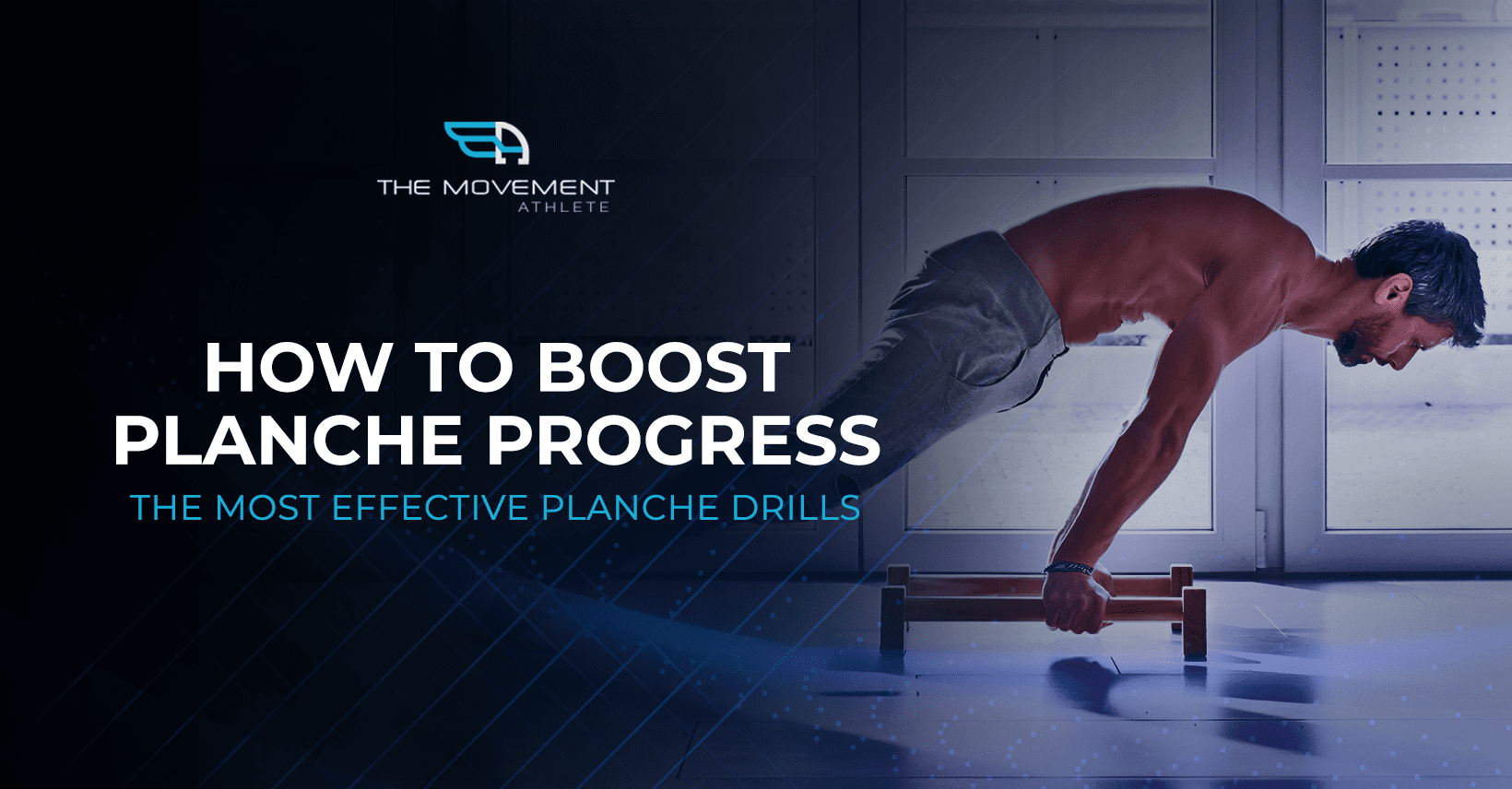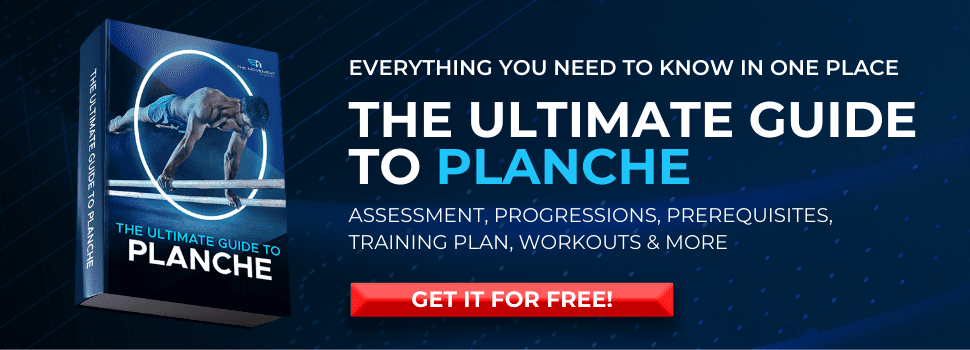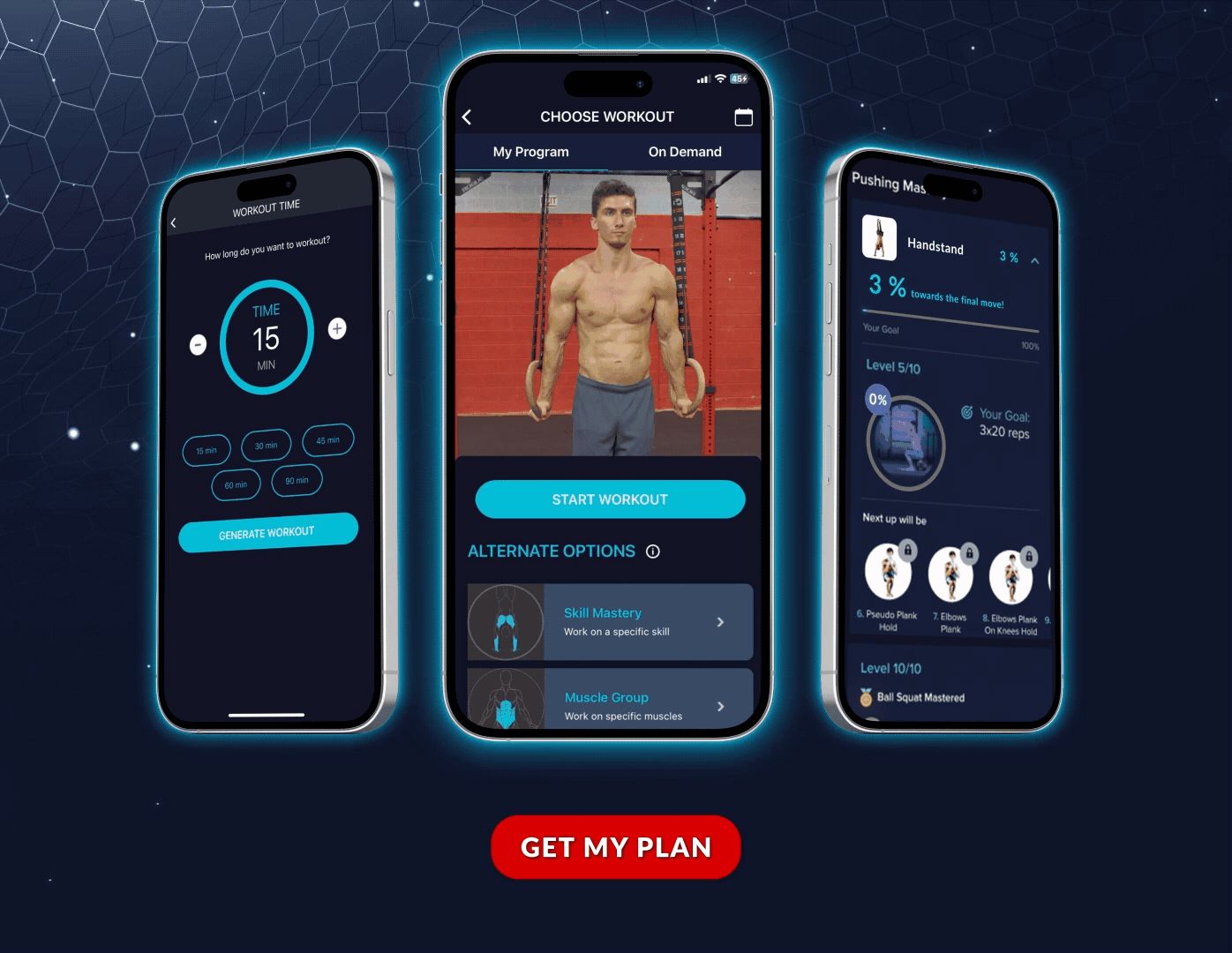

📖 Read Time: 8 Minutes
🏆 Join the Tribe!
Join the tribe of Movement & Calisthenics Athletes – people just like you that are working with their own body weight to get strength, lose fat build muscle, recover from injuries and live their best lives!
Take our FREE Movement Assessment →
TABLE OF CONTENT: The Ultimate Guide to Planche
1. 🧐What is a Planche ? 2. ✅Planche Benefits 3. 🤸♀️Planche – Muscle used and Requirements 4. 📌Planche Training Injury Prevention 5. 🔑How to perform a perfect planche 6. ☑The most effective planche progression 7. ⭐Expert’s effective tips for the perfect planche 8. 🍄Boost planche progress – the most effective planche drills 9. 🔥Planche workout – for all levels 10. 💪Planche training equipment 11. 🤩What’s next after planche? – advanced planche transitions and variations.
PLANCHE EXPERT TIPS AND DRILLS
The best exercise to learn an advanced skill such as a planche is by learning the easier progressions. But you can’t efficiently learn the skill by just attempting the planche over and over again.
You first need to strengthen the key areas and address any weak links through accessory exercises. A combination of the most efficient exercises will not only guarantee a more efficient and faster progress, but also a safer one as well!
There are literally tons of exercises that can supplement your planche journey. For today, let’s take a look at the most effective planche drills.
📑 What’s Covered
- 💪 Strengthen key areas
- 👊 Planche leans
- 👊 Pseudo planche push-ups
- 👉 Wrist mobility exercises
- 👉 Weighted push-ups
- 👊 Banded planche work
- 🎯 Address weak links
- 🤜 Scapula push-ups
- 🤜 Lying 45-degree dumbbell raises
- 🤜 Box rear holds
- 🤜 Hip raises parallettes
💪Strengthen key areas
Planche is a horizontal push exercise that puts great demands on your chest, shoulders, arms and wrists. You can learn more about this in our article Planche Muscles used & Requirement.
That being said, these are the main muscle groups we would want to strengthen in order to launch ourselves in our planche journey.
👊 Planche leans
Planche lean is your go to exercises at any level wherever you are in your planche journey. It simulates the lean that you have to achieve in order to do the planche. With your lower body down on the floor, it allows you to focus on your upper body’s strength and bodyline posture for now.
Planche leans can be scaled to every level, that’s why it is a top priority exercise. You can easily adjust the amount of lean so you can get stronger with it every single time.
Keep in mind the proper from to reap the benefits directly to planche skill work. It’s easy to remember as it’s the same as the form for planche with the exception of your legs being on the floor. For a refresher on form, check out our article on How to Perform Planche.
How to Perform:
- Choose a hand position you are comfortable with. Usually, hands outwards in a 45-degree angle works best.
- Begin in a standard push-up position. Make sure the bodyline is correct while the scapula protracted.
- Shoulders externally rotated outwards.
- Lean forward while maintaining body tension and body position.
- Hold the position for a specific number of seconds.
- Repeat for a number of sets.
👊 Pseudo planche push-ups
Bent-arm strength has a very direct relation with straight-arm strength. This holds especially true if you combine strength-arm strength and bent-arm strength in a single exercise. Introducing the pseudo planche push-ups.
This is basically a planche lean with an added push-up motion. Gains from this exercise are also highly transferable to planche push-ups. Basic push-up form applies to this exercise.
How to Perform:
- Choose a hand position you are comfortable with. Usually, hands outwards in a 45-degree angle works best.
- Begin in a standard push-up position. Make sure the bodyline is correct while the scapula protracted and shoulders depressed.
- Shoulders externally rotated outwards.
- Lean forward while maintaining body tension and body position.
- Lower that until the chest almost touches the ground while retracting the scapula.
- Push-up to the leaning starting position. Avoid rocking back away from the lean.
- Repeat for a number of reps and sets.
👉 Wrist mobility exercises
If we haven’t stressed enough, wrist mobility is essential in planche no matter what hand position you use. Wrist preparation through mobility exercises are vital for efficient and safe progress.
There aren’t any specific wrist mobility exercises you should be looking for, but aim to target to strengthen every motion of your wrists: flexion, extension, pronation, supination, deviations.
You can do wrist rocks, holds and circular motions. Keep the wrist challenged and don’t settle for comfortability. This secures the health of your wrists and is very transferable to other calisthenics exercises as well.
👉 Weighted push-ups
Don’t worry. We haven’t switched to the other side. We simply cannot deny the amazing strength transfer that weighted push-ups have to offer.
As push-up is a horizontal push strengthening exercise, the strength transfer to advanced pushing skills such as planche is amazing. Chest, triceps and anterior deltoids are trained which highly supplements our planche training.
No need to go all out heavy as working with weights in this position could be risky. Keep a good 8-12 rep range for this exercise.
👊 Banded planche work
Resistance band is one of the best pieces of equipment you can work with when learning planche. Bands add support to your body so you can work on more difficult progressions or work on longer duration holds.
Resistance bands also allow you to overload your muscles on more advanced positions. If you’re stuck at tuck planche and wanted to move towards advanced tucks, then bands might be the answer for you.
Don’t overuse your bands! If you haven’t mastered the tuck planche yet, don’t get the strongest resistance bands and attempt the advanced tuck. It might seem nice to boost your ego but it won’t provide you the progress needed for the next progression.
Once you have mastered a planche progression, banded planche bridges the difficulty for the next level. Be honest and objective with banded planche work as it’s easy to rely too much on the band.
How to Perform:
- Choose an appropriate level of resistance bands and set up the anchor point in which the bands should be 90-degrees upright when you perform the exercise.
- Place the bands around your waist.
- Prepare your planche hold: protract scapula, depressed shoulders, engage PPT and core, lock out arms.
- Lean towards your planche progression.
- Hold for a specific number of seconds
- Repeat a number of sets.
🎯Address weak links
When we hit a plateau in our planche journey, we sometimes wonder where we lack even though we’re strong enough in most areas.
Most probable cause of plateau is weaknesses in certain muscles that could either make or break your planche form. Weaknesses are usually present in smaller muscle groups that we don’t place attention to, but still play a major role in holding a planche.
Addressing these weak links allows our body to perform optimally while also reducing the risks of injury. It’s important to value these exercises as they are often neglected and branded as “boring“.
Do not underestimate the benefits of these exercises and perform with maximum effort.
🤜 Scapula push-ups
Planche is all about strong scapula protraction and shoulder depression. This exercise is exactly for that reason.
Scapula push-up is a scalable exercise that increases scapula mobility while strengthening end points of protraction and retraction. While all of this is happening, a strong shoulder depression should be maintained.
This exercise can be scaled through using resistance bands to increase difficulty or switching to a one-arm scapula push-up.
How to Perform:
- Start with a standard push-up position.
- Fully protract your scapula to the top position.
- Slowly retract your scapula while maintaining body posture. Stop until your shoulder blades are pinched together.
- Repeat the motion for a set number of repetitions and sets.
🤜 Lying 45-degree dumbbell raises
Another weighted exercise that provides massive benefits making us unable to pass up on this opportunity. A lying 45-degree dumbbell raise simulates the tension placed on the elbows, biceps and anterior deltoids from a planche. It’s an excellent isolation exercise to strengthen the straight-arm strength without dangerously overloading the arms.
In case you’re wondering about the 45-degree angle, this allows heavier loading on the first motion of shoulder flexion which is highly transferable to the planche motion.
A key note worth mentioning is not going heavy. This is an isolation exercise.
How to Perform:
- Set up a bench where you can recline around 45-degrees.
- Hold two dumbbells appropriate to your skill level.
- Recline on the bench with your body on a 45-degree angle and let your arms begin just below your body.
- Lift the dumbbells with straight arms upwards until your arms are aligned with your chest.
- Slowly lower down the weights with completely locked out arms.
- Repeat the motion for a number of reps and sets.
🤜 Box rear holds
Box rear holds are excellent to teach your lower body the motion when getting into the planche. It’s basically the movement for the lower body without you having to worry about the upper portion of planche.
Usually, when training for planche, we tend to forget about the lower body. Box rear holds is an excellent scalable exercise that will strengthen your core as well as the lower body for the planche position.
There are different leg positions you can use to adjust the intensity. Ranging from tucked, straddle, pike and straight legs which simulates the full planche position.
Don’t worry if you have a training box. Use an alternative that’s available to you. A simple bench or furniture can do the trick.
How to Perform:
- Position your body on the box with your stomach on the floor while hips off the edge of the box.
- From the starting position, extend the hips and legs outwards simulating a planche shape position. Keep your lower back flat and core engaged.
- Hold for a specified amount of time and repeat for a number of sets.
🤜 Hip raises parallettes
Learning how to raise your lower body for the planche is quite a confusing feeling at first. The best way to understand it is by practicing hip raises on parallettes.
This exercise teaches how you’re able to lift your lower body by leaning forward. Without the lean, you won’t be able to raise your hips even by an inch. As you get used to this feeling, you will soon understand the biomechanics more when transferred into planche.
Hip raises also strengthens your anterior deltoids, solidifies your straight-arm strength and builds you a stronger core for planche.
How to Perform:
- Position on a parallettes for a support hold.
- Protract your scapula.
- With locked out elbows, shift your weight forward while pulling your hips upwards until your hips are past your shoulders.
- Lower down with control.
- Repeat the motion for a specified number of reps and sets.
A good planche doesn’t happen by luck. It’s a result of specific training with much effort and dedication.
A combination of primary strengthening exercises and accessory weak link exercises secures efficient and safe progress towards planche.
Free Planche Training Guide
Download our complete guide to mastering planche

Related Articles You’ll Love:
- The Most Effective Planche Progressions
- Expert’s Effective Tips for the Perfect Planche
- Planche Workout – For All Levels
Ready to get started?
Get your free personalized training plan now
